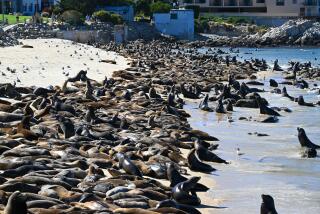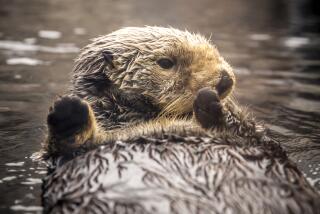Officials of Sea Otter Plan Hope to Continue Despite Failure So Far
Federal wildlife officials hope to continue an effort to establish a sea otter colony on San Nicolas Island, even though it has failed so far.
The Southern Sea Otter Recovery Team plans to ask the California Fish and Game Commission to back a modified program for another year, Jeff Opdyke, a U.S. Fish and Wildlife Service field supervisor, said Monday. The Ventura-based team is part of the Wildlife Service. The project has been co-sponsored by the federal and state agencies for two years.
Four of six members of a committee of scientists established last year to advise the team have recommended that the program continue for another year, and the two other members were expected to concur this week, Opdyke said.
“We pretty much know what we want to do,” said the program’s coordinator, Carl Benz. “It’s just a matter of getting it in black and white.”
The $1-million-a-year program has been criticized by groups representing commercial and pleasure divers and fishermen. They maintain that it is an extravagance at best and at worst a threat to abalone beds that surround the island.
‘Like Vacuum Cleaners’
“Sea otters are very cute and cuddly, but they’re like vacuum cleaners,” said Locky Brown, legislative chairman of the Greater Los Angeles Council of Divers. “They sweep up everything from the sea floor. They don’t leave anything for anybody else.”
A spokesman for the Ventura County Fish and Game Commission, which opposes the program, expressed concern for animals that have been lost or killed during the effort.
“I don’t think they’ve taken into consideration the well-being of the animals themselves,” said Frank Anderson, the commission’s executive secretary.
One hundred and three tagged sea otters have been flown to San Nicolas, the westernmost island in the Channel Islands chain some 80 miles off the Ventura coast, starting in September, 1987. Only 17 are still there, Benz said.
Twenty are known to have returned to colonies along the California coast between Pismo Beach and Santa Cruz, and another moved to Malibu. Eight died, and two are believed to be dead, and 55 are unaccounted for. During the third year, only mature animals that have mated in the past would be taken to the island.
No Births on Island
Officials hope that pups born on the island will stay there, Opdyke said. Otters of various ages have returned to coastal colonies, but no pups have been born on the island, he said.
Even if a colony is established on San Nicolas, federal biologists now doubt that it would accomplish the original goals.
They had hoped to establish a haven for the otter in the event of a major oil spill in the heavily traveled sea lanes along the coast, where animal life is usually hardest hit by such accidents.
“Exxon Valdez showed us that even if a population were established, it’s not going to avert the dangers of an oil slick,” Opdyke said, referring to the tanker that leaked oil onto more than 1,000 square miles in Alaska in May.
He said the project does give scientists a chance to study such aspects of the animal as its homing instinct.
“It doesn’t look like it will be a successful translocation in the long term,” he said of the program. “But it still has high worth for research. Not that much is known about sea otters.”
More to Read
Sign up for Essential California
The most important California stories and recommendations in your inbox every morning.
You may occasionally receive promotional content from the Los Angeles Times.










